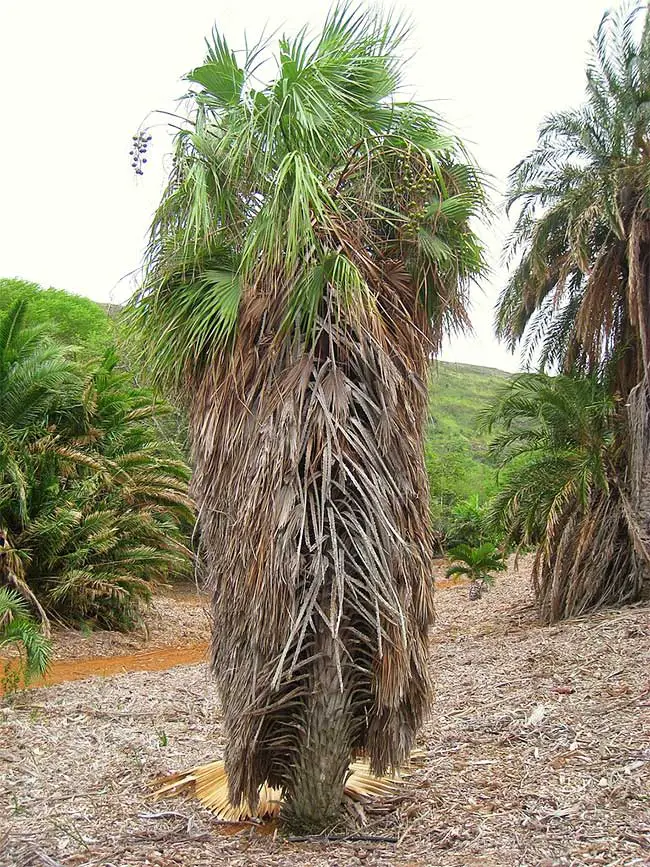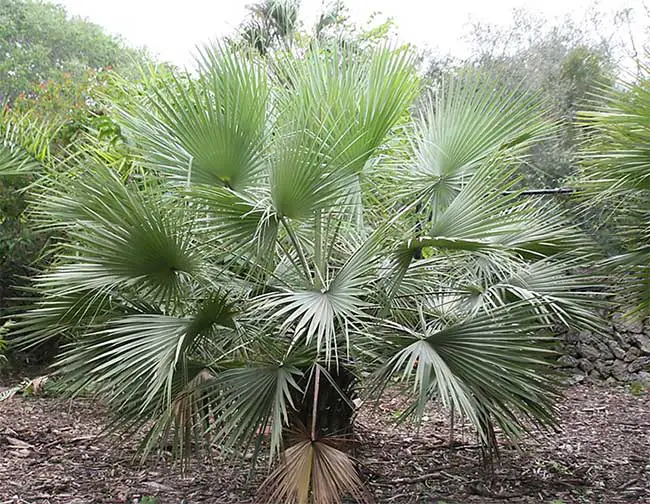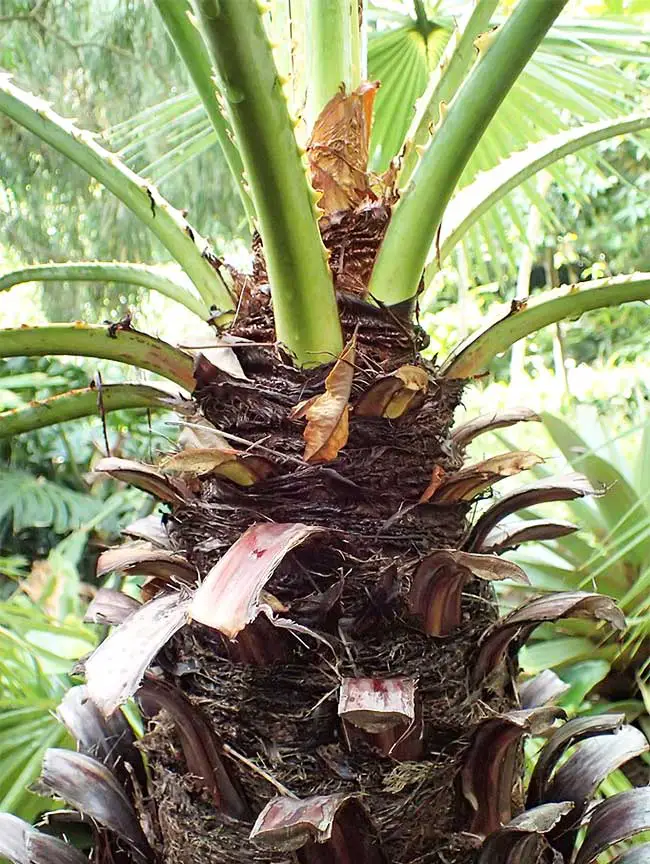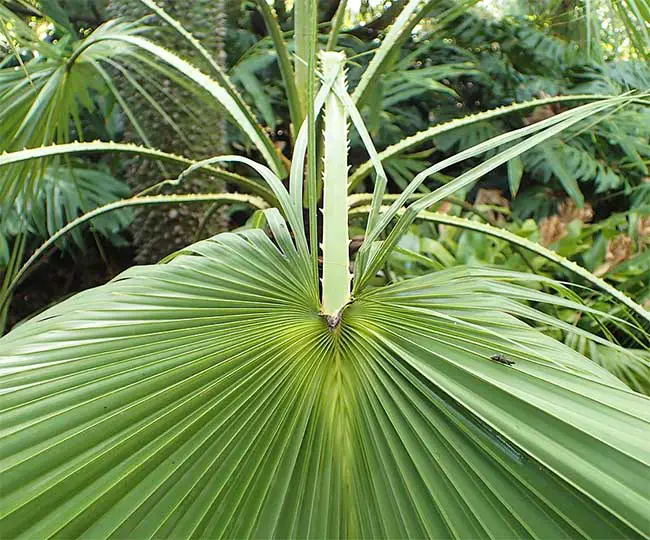
The Sinaloa Hesper Palm, scientifically known as Brahea aculeata, is a captivating palm species native to northwestern Mexico, particularly in the Sinaloa and Sonora regions.
It is characterized by a stout and solitary trunk that can reach heights of up to 30 feet (9 meters), often displaying a grayish-brown color with a textured appearance due to old frond remnants.
One notable feature of the Sinaloa Hesper Palm is its spiny frond bases and leaf stalks, which can be sharp and prickly, lending to its common name, “Spiny Hesper Palm.”
The Sinaloa Hesper Palm is favored in landscaping and ornamental gardening for its unique appearance and adaptability to various climates. It can thrive in both full sun and partial shade, making it a versatile choice for outdoor settings.
Quick Facts:
| Scientific name: | Brahea aculeata |
| Common names: | Sinaloa Hesper Palm, Spiny Hesper Palm, Mexican Blue Palm, Sonoran Blue Palm, Blue Fan Palm |
| Origin: | Native to northwestern Mexico, particularly in the Sinaloa and Sonora regions. |
| Growth Rate: | Slow to Moderate. Up to 20 – 30 ft tall and 10 – 15 ft wide. |
| Cold Tolerance: | USDA Zones 9a (20 to 25 F) to 11 (above 40 F). |
| Light Req: | Partial shade to Full sun. |
| Water Req: | Moderate. |
| Soil Req: | Widely adaptable. |
| Fruit: | Yes. Red. Not edible. |
| Propagation: | By seed. |
Sinaloa Hesper Palm Appearance
This palm typically features a stout, solitary trunk that can attain heights of up to 30 feet (9 meters). The trunk often displays a grayish-brown color and is adorned with the remnants of old fronds, creating a textured and rugged appearance.
The fronds of the Sinaloa Hesper Palm are fan-shaped and relatively large, ranging from 3 to 6 feet (0.9 to 1.8 meters) in length. They are renowned for their striking bluish-green coloration, which lends an attractive and tropical look to the palm.
A distinctive characteristic of this palm is the presence of spiny frond bases and leaf stalks. These spines can be sharp and prickly, adding to the palm’s unique appearance and earning it the common name “Spiny Hesper Palm.”
Flowers and Fruits of the Sinaloa Hesper Palm
The Sinaloa Hesper Palm produces small and inconspicuous flowers. These flowers typically have a cream or yellowish coloration and are arranged in clusters. While they are not particularly showy or fragrant, they play an essential role in the palm’s reproductive process by attracting pollinators, such as insects.
In terms of fruit, the Sinaloa Hesper Palm bears small and spherical berries. Initially, these fruit are green, but as they ripen, they transform into a dark purple or black color. The size of the fruit typically ranges from about 0.5 to 0.75 inches (1.3 to 2 centimeters) in diameter.
While these fruits are not typically consumed by humans, they are a valuable food source for various wildlife species in the palm’s native habitat. Birds and small mammals often feed on the palm’s fruit, contributing to its ecological importance within its ecosystem.
Caring for the Sinaloa Hesper Palm
Caring for a Sinaloa Hesper Palm involves creating a suitable environment to support its growth and overall well-being.
Firstly, consider their sunlight needs. Sinaloa Hesper Palms thrive when they receive an appropriate amount of sunlight. They are versatile, adapting well to both full sun and partial shade, making them an excellent choice for various outdoor settings.
When it comes to soil, choose well-draining soil to prevent water from pooling around the roots. These palms are adaptable and can tolerate different soil types.
In terms of watering, young palms benefit from consistent moisture to establish a strong root system. Mature palms, on the other hand, can tolerate drought but still need regular watering to prevent the soil from becoming overly dry during extended dry periods.
Fertilizing these palms should be done moderately. Apply a balanced, slow-release palm fertilizer once or twice a year during the growing season to ensure they receive essential nutrients.
Pruning requirements for Sinaloa Hesper Palms are generally minimal. Only remove dead or damaged fronds to maintain their health and appearance. Avoid excessive pruning, as it can stress the palm.
Mulching around the base of the palm is beneficial. It helps retain soil moisture, regulates soil temperature, and prevents weed growth.
While these palms are typically resistant to pests, it’s still a good idea to inspect them periodically for common pests like scale and mites and address any issues promptly.
The Sinaloa Hesper Palm exhibits impressive cold hardiness. It can endure cold temperatures down to approximately 15°F to 20°F (-9°C to -7°C), making it well-suited for regions with relatively mild winters. This cold tolerance allows it to withstand occasional frost and chilly conditions without sustaining significant damage.
However, it’s important to note that while the Sinaloa Hesper Palm can handle cold spells quite well, providing protection during severe freezing events, particularly for younger palms or those in borderline cold climates, is advisable to ensure their survival and overall health.
Lastly, if you’re interested in propagating more palms, know that these can be grown from seeds. Sow the seeds promptly after harvesting for the best germination results.
Sinaloa Hesper Palm Pictures




